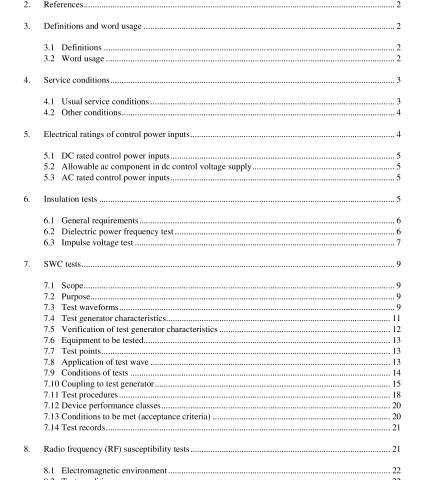IEEE 1613-2003 pdf download.IEEE Standard Environmental and Testing Requirements for Communications Networking Devices in Electric Power Substations
Additional dielectric tests may be made using 75% of the test voltage determined in accordance with Table 2 at the point of installation to determine the practicality of placing or continuing the equipment in service.
6.2.3 Points to be tested Dielectric tests shall be performed
a) Between each independent circuit and the ground circuit. The terminals of each independent circuit may be connected together. For devices with an insulating enclosure, the ground circuit shall be rep- resented by a metal foil covering the entire enclosure except the terminals around which a suitable gap shall be left to avoid flashover to the terminals. Insulation tests requiring this metal foil shall be performed as design tests only.
b) Between independent circuit groups, with the terminals of each independent circuit in the group being connected together. Independent circuit groups are to be defined by the manufacturer.
c) Between the terminals of open contacts—only as a design test. Dielectric tests are not required across contacts with surge-suppression components, nor across solid-state output circuits. If a dielectric test is not performed, the surge withstand capability (SWC) test (see Clause 7) is to be substituted for the dielectric test.
6.2.4 Test method During the testing, no input or auxiliary energizing quantity shall be applied to the device. Test voltage shall be applied directly to the device terminals.
The open-circuit voltage of the testing equipment is initially set to not more than 50% of the specified volt- age. It is then applied to the device under test. From this initial value, the test voltage shall be raised to the specified value, in such a manner that no appreciable transients occur, and then maintained for 1 min. It shall then be reduced smoothly to zero as rapidly as possible.
As an alternate, to be used at the point of manufacture only, it is permissible to test any device for 1 s at a value 20% higher than the standard 1 min test voltage.
6.2.5 Criteria for acceptance
During the dielectric test, no breakdown or flashover shall occur and no components shall be damaged. After the test, the device shall still comply with all relevant performance requirements.
6.3 Impulse voltage test
The impulse voltage test consists of applying a specified impulse voltage to the insulation to prove the abil- ity of the device to withstand, without damage, overvoltages of very high values and very short duration.
6.3.2 Impulse test requirements
Impulse voltage tests are considered design tests. Impulse tests, in accordance with this standard, may be repeated once by the user only on new devices, to determine whether specifications are fulfilled. New devices, for this test, are defined as devices that have not been in service, that are not more than one year old from the date of shipment, and that have been suitably stored to prevent deterioration. Additional impulse tests may be made using 75% of the test voltage given (see 6.3.1) at the point of installa- tion to determine the practicality of placing or continuing the equipment in service.
6.3.3 Points to be impulse tested Impulse voltage tests shall be applied
a) Between each independent circuit and the ground circuit. The terminals of each independent circuit may be connected together. For devices with an insulating enclosure, the ground circuit shall be rep- resented by a metal foil covering the entire enclosure except the terminals around which a suitable gap shall be left to avoid flashover to the terminals.
b) Between independent circuit groups, with the terminals of each independent circuit in the group being connected together. Independent circuit groups are to be defined by the manufacturer.IEEE 1613 pdf download.IEEE 1613-2003 pdf download
IEEE 1613-2003 pdf download

Leave a Reply